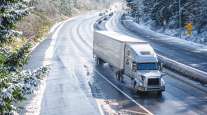Carriers Prepare for Heavy Snowstorms as States Worry About Removal Costs
This story appears in the Jan. 5 print edition of Transport Topics.
When back-to-back snowstorms dumped nearly 7 feet of snow on the New York State Thruway around Buffalo in November, hundreds of truckers were stranded for days — a situation some studies say cost the U.S. economy more than $1 million an hour.
That event followed last year’s long freeze and record snowfall that snarled highway traffic from the Deep South to the Great Lakes, and busted budgets as states struggled to find salt and keep plows running.
The prospect of more storms — this winter and in years to come — is increasingly worrisome, said highway engineers, state transportation officials and truckers.
“We look at all the analytics and monitor [the National Oceanic Atmospheric Administration] and different platforms, and from what I have read, the consensus is we are going to have a similar winter [to] last year, if not worse,” said Donovan Edwards, senior manager of fleet maintenance at Con-way Truckload in Joplin, Missouri.
“We spent over $130 million on snow and ice last winter, and in a typical winter we probably would have spent only $50 [million] to $55 million a year,” said Dan Gullickson, natural resource program coordinator for the Minnesota Department of Transportation.
Fleets are taking it upon themselves to make preparations.
“We ordered salt for our facilities over the summer due to supply oncerns,” said Tom Connery, president of New England Motor Freight, headquartered in Elizabeth, New Jersey. “We also purchased a few additional machines that remove snow from the trailer roof ,which cost $25,000 each.”
Tom Clark, senior vice president of operations at Con-way Freight, told Transport Topics: “We learned a lot of lessons from last year’s polar vortex.”
To better meet winter weather challenges, Con-Way Freight — a unit of Con-way Inc., which ranks No. 4 on the Transport Topics Top 100 list of the largest U.S. and Canadian for-hire carriers — has reserved generators and snow-removal equipment from local rental companies. It is also using “strap-on cleats” for drivers and dockworkers to prevent slips and falls.
The carrier identified “nodes in our network where, in the event of severe weather, we will hold freight, reroute it and not let it travel into weather-impacted locations until safe to do so,” Clark said.
Edwards said Con-way Truckload’s towing costs spiked last year, often due to problems on access roads and parking lots at delivery sites. This year, drivers are being told not to attempt deliveries if there’s a serious risk of snow or ice mishaps. Instead, they are contacting dispatchers, who will then ask customers to clear access points.
More than 70% of the nation’s roads are in snowy regions, according to the Federal Highway Administration. And, according to the 2014 National Climate Assessment, an increasingly warming climate will produce more snow in those areas.
“And more snow right around where we don’t want it, which is right around the freezing point,” said Jim Sullivan of the University of Vermont’s Transportation Research Center.
Higher winter temperatures make snow wetter and heavier, leading to higher road-clearance costs, said Sullivan, who is an engineer.
“The best thing is a real cold powder,” he said. “They can get 2 feet of snow, and it’s a piece of cake; they push it right off the road. But when it’s right around 30 [degrees] and it’s snow and ice and rain, that’s when the salt is 600 pounds a mile.”
State and local governments spend $2.3 billion annually on snow clearance on highways, FHWA said.
To help Vermont manage costs, Sullivan, in 2014, used computer analysis to find the best locations for sheds along highways, so spreaders can replenish without returning to headquarters.
Fifteen years ago, Minnesota began working on a low-tech approach to cut snow-removal costs — snow fences.
The state pays farmers to leave six rows of corn standing along certain highways to keep blowing snow from forming drifts that require dozers and large snow blowers to clear.
“We’ve actually done an inventory of our blowing and drifting-snow sites,” Gullickson said. “Working with our plow operators, we asked them to map out the segments of highway where you have to spend additional resources beyond routine plowing to keep open.”
Those are the sites where the state has asked farmers to leave the corn rows standing, he said.
Minnesota also is experimenting with “living” snow fences — shrub plants that collect blowing snow.
In states that get snow, 20% to 25% of the road-maintenance budgets now are spent on snow and ice control, said Xianming Shi, an engineering professor and pavement expert at Washington State University. “Then they have less money in the summer to build the roads or repair the roads.”
Shi said the obstacles to keeping roads clear are getting complex.
Last winter’s road-salt shortage spurred many states to order more and earlier for this winter even though prices were as high as $100 a ton, compared with $30 to $50 a ton a year ago.
But road salt is environmentally unsound and strongly corrosive, Shi said. That’s why states are experimenting with less corrosive brine mixtures that make use of things such as beet and potato juice in the Midwest, and in Alaska waste from vodka distilleries, he said.
There is also technology on the market to help carriers navigate severe winter weather events.
Baron Services, a Huntsville, Alabama, company with a deep bench of meteorologists, for example, offers weather data and analysis to various business sectors, including telecommunications companies that provide in-cab navigation and communications equipment to trucking companies.
The software can help operations managers determine when and if to send a truck along a route during weather events, said Baron’s director of business development, Chris Carr.
“We do that level of science to find out the exact point in time when winter weather becomes an issue on the road surface,” he said.
Baron also works with other technology firms and trucking companies on software that mixes driver-safety data with weather data, Carr added.




